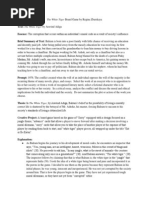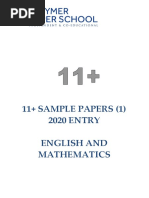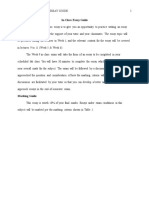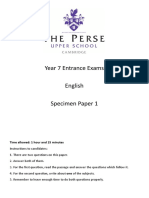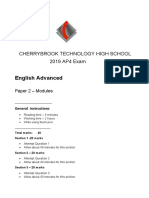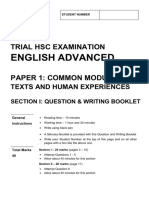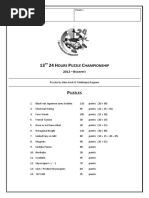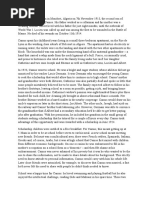Booklet 11
Booklet 11
Uploaded by
rubbengCopyright:
Available Formats
Booklet 11
Booklet 11
Uploaded by
rubbengOriginal Description:
Copyright
Available Formats
Share this document
Did you find this document useful?
Is this content inappropriate?
Copyright:
Available Formats
Booklet 11
Booklet 11
Uploaded by
rubbengCopyright:
Available Formats
Logic Puzzles booklet #11 2002-2003 Tim Peeters (http://www.home.zonnet.
nl/kostunix/)
Dear puzzle(d) friends, This is already my 11th booklet with logic puzzles made especially for all you puzzlers in the world. This 11th booklet was also supposed to be my last due to lack of feedback, which, for me, automatically meant I was making puzzles for a (very) small audience. This lack of feedback already changed my plans from issuing a booklet every two months in issuing a booklet whenever I felt like it. But thanks to a lot of positive reactions during this years WPC, I'll give it another go. I also think it's time that I give you all a proper introduction. So here's some background information about how I became a puzzle addict. In high school I first discovered my ability to make and solve puzzles. Every now and then I made a practice test for the physics exams, and went in discussion with our mathematics teacher about the answers in the answer booklet. (I remember a discussion about how many cartons of orange juice fit in a special sized box. Everybody stacked the cartons in an upright position in the box, but I tried to put in cartons on their side and on their back as well, resulting in two extra cartons that would fit in.) I became a real puzzle addict after I qualified for the 8th WPC in Budapest back in 1999. I just managed to get through the qualification round and the Dutch national round to enter the team. On one of our first meetings before the event in Budapest, Niels Roest (our nations best puzzler) handed in two retrograde battleship puzzles. He made those for Breinbrekers and was awarded a free subscription for the forthcoming year. Since I still had no subscription to Breinbrekers, I also started to develop some puzzles. I drove Hans Eendebak, team captain and editor of Breinbrekers, mad with all the stuff I "invented". I would send him two or three puzzles every two weeks. I was also looking for a place to do my practical (I was studying mathematics at the time (what else would you expect)) and also that request I mailed to Hans. After this all went very quickly. Hans offered me the chance to fill the "yellow section" of Breinbrekers for the 3rd issue of 2000. All these kind of puzzles also feature in my booklets and two concepts even made it through the WPC 2003 puzzle selection. (Checkers and tournament, puzzle 3 and 13 of part II). I also did my practical at Puzzelsport in the summer of 2000. I developed (another) "Swedish crossword puzzle generator" for them. After this I became a regular puzzle maker for Breinbrekers, and I'm doing this ever since. In 2001, after a disappointing 9th place in the national finals in 2000, I again made it to the WPC. On that event Hans made clear that he wanted to nominate the Netherlands to host the event in 2003. He was making an inventory of all people he wanted to help him with the content. I was one of them. And although I finished 6th that year, in my heart I felt more a puzzle maker rather than a puzzle solver. (The 2001 WPC was very mathsorientated, so it was very easy for me to do well in the event). Here I am, in 1999 struggling to get to the event as a puzzle solver, and now making puzzles for the event. I would like to thank a number of people for this: First of all Hans Eendebak who not only hired me to work for Puzzelsport but also did a great job as a team captain in the 1999 and 2001 event, and as the responsible man for this years WPC-puzzles. It is an honor to work with you. I hope this won't be our last event together! Secondly there are all the Dutch team members I've served with in 1999 and 2001 (in alphabetical order): Jan Beelen, Paul Jacobs, Delia Keetman, Jeroen Meewisse and Niels Roest. Damn good puzzlers you all. Further more all the people I worked with this 12th WPC: Rob Geensen and Jan Lam from the organizing staff, Delia and Stef Keetman as fellow puzzlemakers, Rick Uppelschoten my roommate for the event, for listening to my on- and ongoing stories, even way past 4 AM. And last but definitely not least all the people who either helped to check the solutions, handed out and took in the "exams" or organized the excursions and all the people at Papendal, who made this a great championship. Congratulations all on a fantastic event. Also all puzzlers present at the last WPC and all puzzlers enjoying my booklets, thank you very much for all your interest. In particular I'd like to thank Otto Janko who translated all my puzzles into the German language. And all the others who link to my home page. And finally I would like to thank my wife Sonja, I love you, and also my family for their support, I couldn't have done it without you!!! Tim Peeters October 2003
Logic Puzzles booklet #11 2002-2003 Tim Peeters (http://www.home.zonnet.nl/kostunix/)
Japanese sums (****)
Place figures 1~9 in the grid, different figures in each row or column. The numbers outside the grid indicate the sum of the figures filled in consecutive. Different sums must be separated by at least one black square.
3 6 15 10 11 13 8 10 18 7 19 26 25 10 12 14 23 24 12 14 6 9 2 12 9 26 22 10 8 15 16 11 15 12 21 17 6 12 5 16 7 25 4 14 9 20 2 22 18 11 15 13 10 13 16 16 7 5 8 7 14 11 18 8 7 10 15 16 8 19 16 6 14 16 19 6 24 11 14 12 3 9 26 21 2 9 18 13 25 16 14 13 11 21 3 1 3 25 18 10 11 19 17 2 8 15 7 13 29 7 18 13 25 9 6
This type of puzzle featured in part V. The first team assignment "assorted puzzles". Stef Keetman first made a very similar hexagonal version of it, from which I derived this concept.
Logic Puzzles booklet #11 2002-2003 Tim Peeters (http://www.home.zonnet.nl/kostunix/)
Spy hole (***)
The floor has been divided into 64 rooms, which are all interconnected by doors. Some doors are open, others are closed. In some rooms there is a figure that indicates how many other rooms can be looked into. Which doors are closed?
This type of puzzle, with a figure in all the rooms, Hans first came across in Games magazine. He used it in the 2002 Dutch finals and asked me afterwards to make some puzzles of this type for Breinbrekers. I did, and soon omitted a lot of figures from the puzzles to make them more difficult. This alteration made it on the A-list for the WPC.
Logic Puzzles booklet #11 2002-2003 Tim Peeters (http://www.home.zonnet.nl/kostunix/)
Take circles (**)
Find a path from the top left corner to the bottom right corner so that you pass through every circle once. The path may not touch itself, not even diagonally.
This was an alternative "step 4 puzzle" for the individual medley. Instead of the "every second breakpoint"-puzzle.
Double Domino (**)
Two sets of dominos are hidden in the grid. One is placed vertically and the other set is placed horizontally. Draw the sides in the diagram so that it becomes clear how the dominos are positioned.
5 3 4 3 1 3 2 2 4 4 5
3 0 6 3 3 6 3 4 3 6 3
1 6 6 3 2 3 0 0 3 3 4
5 1 1 0 0 5 2 6 6 4 6
1 5 2 2
0 0 6 5
0 2 3 5
6 0 0 4
5 2 2 2
2 2 5 5
1 4 5 0 6 4 4 6 6 3 1
1 2 5 0 5 1 1 1 1 1 2
4 6 4 0 5 4 5 5 1 2 1
6 2 4 0 4 6 4 0 3 1 0
We wanted a domino variations part. So I started to think of some variations. From the three I invented only the cross-sums domino made the A-list. Because of the extra rule (one set horizontally and one set vertically) this puzzle was rejected in favor of one without this rule.
Logic Puzzles booklet #11 2002-2003 Tim Peeters (http://www.home.zonnet.nl/kostunix/)
Strange Domino (***)
A strange set of dominos is hidden in the grid. Draw the sides in the diagram so that it becomes clear how the stones are positioned.
2 2 2 1 2 1 2 2 3
1
2 1 1 3 3 3 1 3 3
1 3 1 3 3 1 2 3 1
2
2 3 2 3 1 2 2 3 1 2 3 1 3 1 1 2 3 2 1 1 1 2 1 3 1 3 1 2 3 1 3 2 1
3 2 2 1 1 2 3 1 2 3 3 1 1 3 1 2 3 1 3 3 2 2 2 2 3 3 3 3 3
2 2 2 3 2 1 3 3 2
1 3 1 1 1 1 2 1 1 3 1 2 1 2 2 2 3 3 1 3
1 1 2 1 2 2 1 3 2 2 1 3 2 3 2 3 2 3
Although this is a full set of strange dominos, which can't be said about the WPC-puzzle, it didn't make it to the Alist because this puzzle was too hard.
Logic Puzzles booklet #11 2002-2003 Tim Peeters (http://www.home.zonnet.nl/kostunix/)
3D Dungeon (*)
Find your way through this maze. You can't cross your path. On your way you make three pictures. Find a route from the left upper corner to the right bottom using the three pictures in the order you took them.
Pictures 1, 2 & 3
This puzzle was planned for the dirty dozen (instead of Hiroimono). But we believed it was too complicated to explain. In these pictures you can look over some walls. What is there? In the last picture you can't see the end of one of the corridors. Does it go on forever? All kinds of questions you can answer with: "you don't need that information to solve the puzzle". So to avoid all these questions we just skipped this puzzle.
Logic Puzzles booklet #11 2002-2003 Tim Peeters (http://www.home.zonnet.nl/kostunix/)
Retro pentomino (****)
A full set of twelve different pentominos can be found in the diagram. They do not touch each other, not even diagonally. Find their placing.
The problem with this puzzle is that there are mirrored pentominos in this diagram. A puzzler might think that the L-shape in the top left corner is a different shape than the L-shape on the bottom, which is mirrored. I corrected this flaw and that puzzle made the A-list.
Just twelve steps (****)
Start in the upper left square. Jump in every direction you want. The number in a square indicates the distance of your jump. You're not allowed to jump outside the grid. Your goal is to travel exactly to F in exactly twelve steps.
5 3 2 3 6 4 4 4 3 6
3 4 5 2 4 6 4 5 6 1
4 2 1 5 3 5 1 4 2 2
1 3 5 3 2 3 5 1 2 6
2 3 4 4 2 6 2 4 1 4
5 1 5 3 3 5 1 3 6 3
4 5 2 4 6 3 6 4 2 4
3 3 5 4 3 1 4 5 2 2
5 3 5 2 3 3 6 4 6 3
2 5 3 4 5 5 3 2 5 F
This was one of the hardest puzzles to crack this year. It was possible to go to F in less than twelve steps, but that was not the question... In this puzzle there is a unique solution in both eleven and twelve steps. Can you find them both?
Logic Puzzles booklet #11 2002-2003 Tim Peeters (http://www.home.zonnet.nl/kostunix/)
Triminos (***)
Use the 25 pieces to fill in the pyramid. Only edges and corners with the same numbers can touch.
This was my idea for the weakest link round. Every puzzler who finishes gets some of these tiles to form their team's pyramid. This couldn't be realized due to practical reasons. All those bags of tiles, the costs,... This concludes my 11th booklet. Comments, feedback, questions are all welcome at kostunix@zonnet.nl
Tim Peeters, October 2003
You might also like
- Varjak Paw BookletDocument12 pagesVarjak Paw Bookletkhadijahesham00No ratings yet
- Statistics Booklet For NEW A Level AQADocument68 pagesStatistics Booklet For NEW A Level AQAFarhan AktarNo ratings yet
- Highgate Maths A AnswersDocument10 pagesHighgate Maths A AnswersJianfeng TianNo ratings yet
- Haberdashers Aske S Boys School HABS 11 Plus English 2009 Sample PaperDocument4 pagesHaberdashers Aske S Boys School HABS 11 Plus English 2009 Sample PaperAaron BakerNo ratings yet
- Diana ProjectDocument30 pagesDiana ProjectmozubhattiNo ratings yet
- Towards A Democratic Media - Strategic Media Planning v3Document18 pagesTowards A Democratic Media - Strategic Media Planning v3606No ratings yet
- 13 English Mark Scheme Iseb Papers 1 2 2013Document8 pages13 English Mark Scheme Iseb Papers 1 2 2013Heiton ZengNo ratings yet
- Alleyn's School 13+ English Sample Examination Paper 1Document7 pagesAlleyn's School 13+ English Sample Examination Paper 1lusavkaNo ratings yet
- 2014 EnglishDocument13 pages2014 EnglishAlyssa LNo ratings yet
- Definition of Loyalty Example EssayDocument3 pagesDefinition of Loyalty Example EssayimsungbaekNo ratings yet
- English: For Pupils Currently in Year 6Document8 pagesEnglish: For Pupils Currently in Year 6Ravshonbek OtojanovNo ratings yet
- 2013 EnglishDocument13 pages2013 EnglishAlyssa LNo ratings yet
- GCSE CheatSheet v2 - JORDocument2 pagesGCSE CheatSheet v2 - JORHelp GloPosNetNo ratings yet
- Analysing Newspaper StoriesDocument3 pagesAnalysing Newspaper StoriesMarceloNo ratings yet
- Investigative Journalism Manual Chapter 6Document35 pagesInvestigative Journalism Manual Chapter 6Sipos Zoltán100% (2)
- The One Room School - Williamsport's LegacyDocument120 pagesThe One Room School - Williamsport's LegacyNancyNo ratings yet
- Progress Test 2Document2 pagesProgress Test 2Sipahy E MahiDi0% (1)
- Highgate English CDocument7 pagesHighgate English CJianfeng TianNo ratings yet
- Highgate 2020 11 English Exemplar 2 UnlockedDocument6 pagesHighgate 2020 11 English Exemplar 2 Unlocked微信:London-001No ratings yet
- The White Tiger Creative ProjectDocument3 pagesThe White Tiger Creative Projectzregina96100% (1)
- PracticalDocument6 pagesPracticalVandan NagdaNo ratings yet
- Practical How Does Temperature Affect The Diffusion of Pigment Across Beetroot Cell WallsDocument4 pagesPractical How Does Temperature Affect The Diffusion of Pigment Across Beetroot Cell Wallszakolc49No ratings yet
- Eton Practice PapersDocument22 pagesEton Practice PapersvickyNo ratings yet
- Sample Papers I 2020 Entry LatDocument29 pagesSample Papers I 2020 Entry LatJianfeng TianNo ratings yet
- In Class Essay GuideDocument3 pagesIn Class Essay GuideMichael NguyenNo ratings yet
- Family Relationships in King Lear and King of EnglandDocument6 pagesFamily Relationships in King Lear and King of EnglandJeremy RichuNo ratings yet
- Shine 11+ EnglishDocument10 pagesShine 11+ EnglishsohaNo ratings yet
- Puzzles and RiddlesDocument4 pagesPuzzles and RiddlesPercy Jason BustamanteNo ratings yet
- Hornsby Girls 2023 English Ext 1 TrialsDocument7 pagesHornsby Girls 2023 English Ext 1 Trialsalex.j.vanesNo ratings yet
- 4 Reading - Reading Comprehension PassageDocument14 pages4 Reading - Reading Comprehension Passagestocks30150% (2)
- GCSE 1MA1 Paper 2H (Mock Set 2) PDFDocument24 pagesGCSE 1MA1 Paper 2H (Mock Set 2) PDFamnaNo ratings yet
- Romeo and Juliet EssayDocument2 pagesRomeo and Juliet EssayWitnyNo ratings yet
- King Lear AnalysisDocument3 pagesKing Lear AnalysisKharthik RamanathanNo ratings yet
- Read The Extract A Study in Scarlet' and Then Answer All of The QuestionsDocument7 pagesRead The Extract A Study in Scarlet' and Then Answer All of The QuestionsVungusNo ratings yet
- Forest School 11+ English Sample Paper 2020Document12 pagesForest School 11+ English Sample Paper 2020微信:London-001100% (1)
- MR Bruffs GCSE English Revision Guide SampleDocument10 pagesMR Bruffs GCSE English Revision Guide SampleSam GreenNo ratings yet
- The Perse School 11 Plus English Specimen Paper 1Document7 pagesThe Perse School 11 Plus English Specimen Paper 1Aaron BakerNo ratings yet
- Carpet Weavers, Morocco AnalysisDocument14 pagesCarpet Weavers, Morocco AnalysisBrandon AndreasNo ratings yet
- LiteratureDocument20 pagesLiteratureKirthika JaganNo ratings yet
- An Inspector Calls Revision Booklet Higher 13xmb6pDocument12 pagesAn Inspector Calls Revision Booklet Higher 13xmb6pArvin TaylorNo ratings yet
- gl2732 Cat4 Quick Start Guide 2021Document12 pagesgl2732 Cat4 Quick Start Guide 2021jasleenpoonie100% (1)
- Specimen English Questions: 10+ Deferred EntryDocument4 pagesSpecimen English Questions: 10+ Deferred EntryJack HawkinsNo ratings yet
- Forest School 11 English Sample Paper 5Document7 pagesForest School 11 English Sample Paper 5微信:London-001No ratings yet
- Cherrybrook 2019 English Trial Paper 2 AdvancedDocument8 pagesCherrybrook 2019 English Trial Paper 2 AdvancedlaraNo ratings yet
- Hurlstone 2019 English Trial Paper 1Document32 pagesHurlstone 2019 English Trial Paper 1Kristy LamNo ratings yet
- AQA Biology Required Practical Science RevisionDocument85 pagesAQA Biology Required Practical Science Revisionlimited humanNo ratings yet
- How To Write An EssayDocument19 pagesHow To Write An EssayTroy SouthwellNo ratings yet
- Barker 2019 English Trial Paper 1Document20 pagesBarker 2019 English Trial Paper 1Kelvin ChenNo ratings yet
- Critical Reasoning AssignmentDocument14 pagesCritical Reasoning Assignmentwordpandit100% (3)
- King Lear EssayDocument3 pagesKing Lear EssayBryce Ozzie BeaumontNo ratings yet
- Cambridge IGCSE: 0500/11 First Language EnglishDocument16 pagesCambridge IGCSE: 0500/11 First Language EnglishAustin RexNo ratings yet
- Maclaurin 14Document3 pagesMaclaurin 14ichkhuyNo ratings yet
- Alleyn's School 13+ English Sample Examination PaperDocument5 pagesAlleyn's School 13+ English Sample Examination PaperlusavkaNo ratings yet
- An Inspector Calls (Revision Guide) IDocument21 pagesAn Inspector Calls (Revision Guide) IMenon HariNo ratings yet
- King LearDocument14 pagesKing LearNuzul ImranNo ratings yet
- 11 English Entrance Exam 10Document7 pages11 English Entrance Exam 10ecartetescuissesNo ratings yet
- Comparing Checking Out With The EmigreeDocument2 pagesComparing Checking Out With The EmigreeSebastian Marteau MariaNo ratings yet
- Year 10 English IGCSE AnthologyDocument19 pagesYear 10 English IGCSE Anthologyshimoni rathore100% (1)
- Aldenham School 2017 11 English Sample Paper Answer Key UnlockedDocument2 pagesAldenham School 2017 11 English Sample Paper Answer Key Unlocked微信:London-001No ratings yet
- Normanhurst Boys 2019 English Trial Paper 1Document14 pagesNormanhurst Boys 2019 English Trial Paper 1Kelvin ChenNo ratings yet
- 13E/14E Model Question Paper English Part-A and BDocument8 pages13E/14E Model Question Paper English Part-A and Bsdcreports view100% (1)
- Epsom College 11 Specimen EnglishDocument8 pagesEpsom College 11 Specimen English微信:London-001No ratings yet
- Kendriya Vidyalaya No.2 A.F.S Tambaram: Dots and Boxes GameDocument19 pagesKendriya Vidyalaya No.2 A.F.S Tambaram: Dots and Boxes Gamedhruv goraiNo ratings yet
- Week 1Document2 pagesWeek 1rubbengNo ratings yet
- Jocuri Logice GreleDocument15 pagesJocuri Logice GrelerubbengNo ratings yet
- WPF NewsletterDocument32 pagesWPF NewsletterrubbengNo ratings yet
- Rebus Logic Din RusiaDocument7 pagesRebus Logic Din RusiarubbengNo ratings yet
- 6th OAPC No PasswordDocument11 pages6th OAPC No PasswordrubbengNo ratings yet
- The Money ChangersDocument37 pagesThe Money Changerspaliacho77No ratings yet
- Longtin ECT Paper2 KKDocument10 pagesLongtin ECT Paper2 KKSamuel SimbolonNo ratings yet
- George CansecoDocument2 pagesGeorge CansecoJenielyn MadarangNo ratings yet
- Skim and ScanDocument19 pagesSkim and ScanAlice100% (1)
- Print Media in The PHDocument3 pagesPrint Media in The PHlexis aNo ratings yet
- "A Message To Garcia": ForewordDocument4 pages"A Message To Garcia": ForewordDave M.No ratings yet
- Student Council Constitution: Article IDocument4 pagesStudent Council Constitution: Article Iapi-329669075No ratings yet
- Between Ashes and HopeDocument288 pagesBetween Ashes and Hopemohaiemen100% (1)
- Cambridge English Advanced LeafletDocument2 pagesCambridge English Advanced Leafletkicsireka100% (1)
- Dan Streible, Charles Musser Fight Pictures A History of Boxing and Early CinemaDocument418 pagesDan Streible, Charles Musser Fight Pictures A History of Boxing and Early CinemaCole100% (1)
- Custom Home Fall 2013Document90 pagesCustom Home Fall 2013Harun KaleNo ratings yet
- Edgar Allan PoeDocument33 pagesEdgar Allan PoeWagner Da CruzNo ratings yet
- Are The Following Sentences Active or Passive? Tick The Passive SentencesDocument2 pagesAre The Following Sentences Active or Passive? Tick The Passive SentencesSol PeiranoNo ratings yet
- The Metropolitan Museum Journal V 30 1995Document104 pagesThe Metropolitan Museum Journal V 30 1995Evelina TomonyteNo ratings yet
- Text To Speech Synthesis For Ethiopian Semitic Languages: Issues and The Way ForwardDocument4 pagesText To Speech Synthesis For Ethiopian Semitic Languages: Issues and The Way ForwardMebiratu Beyene0% (1)
- British Birds-May 2020Document71 pagesBritish Birds-May 2020Roberto Savoia100% (1)
- Advertising Budgeting, Media, and Media PlanningDocument45 pagesAdvertising Budgeting, Media, and Media PlanningAbesheik HalduraiNo ratings yet
- Recording Analysis of J.S. Bach's G Minor Adagio For Solo Violin (Excerpt) : A Case Study.Document47 pagesRecording Analysis of J.S. Bach's G Minor Adagio For Solo Violin (Excerpt) : A Case Study.Desmon M SiburianNo ratings yet
- The Study of DiscourseDocument14 pagesThe Study of DiscourseadirenaldiNo ratings yet
- Part 4 Media Research MethodsDocument79 pagesPart 4 Media Research MethodsDEEPAK GROVERNo ratings yet
- QAed SLM 5 Grade 4Document36 pagesQAed SLM 5 Grade 4lorna magosNo ratings yet
- II Love Magazine II Love PDF Mag Is Copyright© 2009Document63 pagesII Love Magazine II Love PDF Mag Is Copyright© 2009dubiluj100% (1)
- Albert Camus Was Born in MondoviDocument9 pagesAlbert Camus Was Born in MondovianggaNo ratings yet
- Libel in ArtDocument17 pagesLibel in ArtSteve BackenstoesNo ratings yet
- Corel Painter - 03 - Magazine, Art, Digital Painting, Drawing, Draw, 2d (ChrisArmand) PDFDocument86 pagesCorel Painter - 03 - Magazine, Art, Digital Painting, Drawing, Draw, 2d (ChrisArmand) PDFAnonymous qTUAQkqHML100% (1)



















